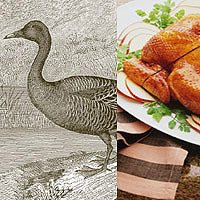health guides
Goose

Preparation, Uses, & Tips
Check for any feathers and remove from skin. Wash goose thoroughly in cold water and pat dry with paper towel. Goose should always be cooked until well done. For best results, use a meat thermometer inserted in the meatiest part of the bird. Goose is done when internal temperatures read at least 165°F (74°C). To test for doneness without a thermometer, make sure a fork can be easily inserted, and that when the meat is pricked the juices run clear (not pink).
Roasting
Thoroughly prick the goose’s skin without piercing the flesh. Place goose on a rack in a shallow saucepan (though it should be at least an inch [2.5cm] deep), breast side up. Pour a small amount of water or stock in the saucepan. Place goose in an oven preheated to 450°F (230°C) for 15 minutes, then lower the temperature to 350°F (180°C). Roast for 20 minutes per pound (454g), or until internal temperature reaches at least 165°F (74°C). Baste occasionally with saucepan liquids. If parts of the bird become too brown, shield them with foil. Let stand 15 minutes before carving.
Poaching
Place goose in simmering cooking liquid (water, wine, or broth) that is flavoured with herbs, spices, and vegetables. Cook a young goose for one hour; a goose weighing 10 pounds (4,500g) or more for two hours. Remove goose from stock and brown it by baking it in an oven preheated to 450°F (230°C) for five to ten minutes.
Copyright © 2024 TraceGains, Inc. All rights reserved.
Learn more about TraceGains, the company.
The information presented in the Food Guide is for informational purposes only and was created by a team of US–registered dietitians and food experts. Consult your doctor, practitioner, and/or pharmacist for any health problem and before using any supplements, making dietary changes, or before making any changes in prescribed medications. Information expires December 2024.


 We are proud to announce that
We are proud to announce that  As the market evolves, customers increasingly request a wider variety of omega-3 options for their lipid...
As the market evolves, customers increasingly request a wider variety of omega-3 options for their lipid...  Maintaining healthy glucose levels is crucial for preventing metabolic conditions like diabetes,...
Maintaining healthy glucose levels is crucial for preventing metabolic conditions like diabetes,...  Looking at formulating a new vitamin blend? Discover
Looking at formulating a new vitamin blend? Discover 







































